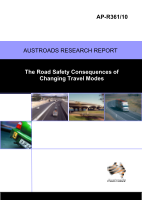Road Safety

- Publication no: AP-R361-10
- ISBN: 978-1-921709-31-9
- Published: 1 July 2010
- PDF (free) Download
Understanding the extent of changes in modal shift and their consequences in terms of road deaths and injuries is essential if we are to fully understand progress towards the targets of the National Road Safety Strategy, and the actions that may be needed to ensure that the targets are met. For example, a shift to higher-risk modes such as cycling or motorcycling could have a detrimental effect on progress towards road safety targets unless suitable infrastructure and supporting measures are provided in time to cater for these changes. New actions in response to changed circumstances may therefore be required to keep targets on track.
The objective of the project is to provide policy makers with information about the likely consequences in terms of road casualties which would result from different levels of change in travel modes to assist with long-term planning for road safety.
- 1. INTRODUCTION
- 1.1. Objective
- 1.2. Literature Review
- 2. DATA SOURCES
- 2.1. Starting Point – the Survey of Day-to-day Travel in Australia
- 2.2. Sources for Updating Travel Estimates
- 2.3. Crash Data Sources
- 3. METHOD FOR ESTIMATING EXPOSURE AND CRASH RATE
- 3.1. Car Drivers and Motorcyclists
- 3.2. Car Passengers
- 3.3. Bicyclists and Pedestrians
- 3.4. Time Spent Travelling
- 4. FATALITIES AND SERIOUS INJURIES PER KILOMETRES TRAVELLED
- 4.1. Fatalities and Serious Injuries per Kilometres Travelled by Age
- 4.1.1. Drivers
- 4.1.2. Car Passengers
- 4.1.3. Motorcyclists
- 4.1.4. Bicyclists
- 4.1.5. Pedestrians
- 4.2. Fatalities and Serious Injuries by Time of Day
- 4.2.1. Car Drivers
- 4.2.2. Car Passengers
- 4.2.3. Motorcyclists
- 4.2.4. Bicyclists
- 4.2.5. Pedestrians
- 4.3. Fatalities and Serious Injuries by Day of Week
- 4.3.1. Car Drivers
- 4.3.2. Car Passengers
- 4.3.3. Motorcyclists
- 4.3.4. Bicyclists
- 4.3.5. Pedestrians
- 5. FATALITIES AND SERIOUS INJURIES PER TIME TRAVELLING
- 6. SUMMARY OF EXPOSURE ESTIMATES
- 6.1. Accuracy of the Travel Estimates
- 6.2. Comparison of Rates for Different Modes, 1984 and 2006
- 7. INCREASED TRAVEL BY VULNERABLE ROAD USERS
- 7.1. Frequency of Cycling and Walking and Fatality and Injury Rates
- 7.2. Studies from Australia and New Zealand
- 7.3. ‘Safety in Numbers’ and Safe System Principles
- 8. SCENARIOS FOR CHANGES IN CRASH OUTCOMES
- 8.1. Motorcycling
- 8.2. Walking
- 8.3. Bicycling
- 8.4. Changes in Travel at High-risk Times
- 8.5. Changing Modes
- 8.6. Changing Modes Involving Additional Walking
- 8.7. Freight Scenarios
- 9. CHALLENGES TO ACHIEVING ROAD SAFETY TARGETS
- 9.1. Limitations of the Study
- 9.2. The Challenges
- 9.3. Possible Strategies to Address the Challenges
- 9.3.1. Measuring Exposure by Different Modes
- 9.3.2. Alternatives to Motorcycling
- 9.3.3. Improving the Safety of Motorcycling
- 9.3.4. Improving the Safety of Walking and Bicycling
- 9.3.5. Coping with the Freight Task
- 9.4. The Next Steps
- 9.4.1. Research
- 9.4.2. Action
- 10. CONCLUSIONS AND RECOMMENDATIONS
- 10.1. Conclusions
- 10.2. Recommendations for Research
- 10.3. Recommendations for Actions to Improve the Safety of Vulnerable Road Users
- REFERENCES
- APPENDIX A DRIVER FATALITIES AND SERIOUS INJURIES BY AGE BY KILOMETRES TRAVELLED BY JURISDICTION
- APPENDIX B CRASH RATES BY AGE AND GENDER FOR DIFFERENT TRAVEL MODES, QUEENSLAND
